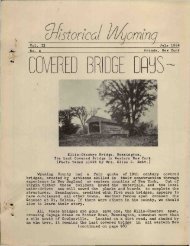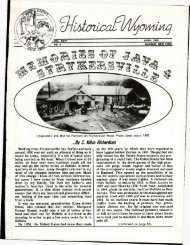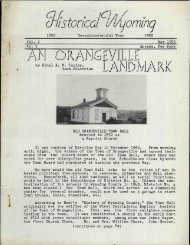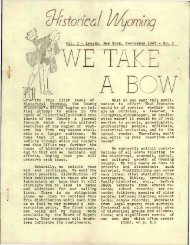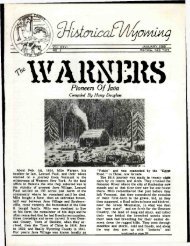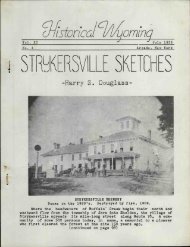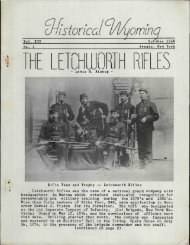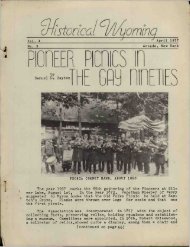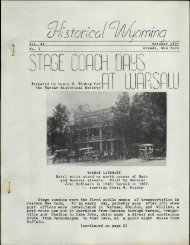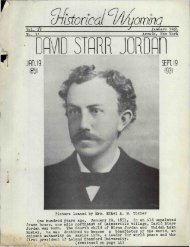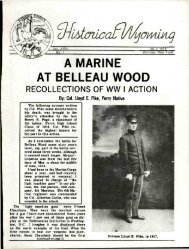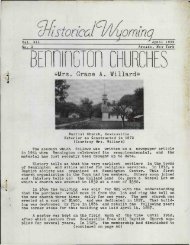y o m i n q by Harry S. Douglass - Old Fulton History
y o m i n q by Harry S. Douglass - Old Fulton History
y o m i n q by Harry S. Douglass - Old Fulton History
You also want an ePaper? Increase the reach of your titles
YUMPU automatically turns print PDFs into web optimized ePapers that Google loves.
April 1954<br />
CURRIERS THROUGH THE YEARS (cont.)<br />
Page 75<br />
thereafter, the Sardinia route was abandoned and the narrow-gauge<br />
line run to Ardade and Cuba, the road being Known as the Tonawanda<br />
Valley & Cuba R. R. The T. V. was sold at foreclosure in 189^ and<br />
a new line, the Buffalo, Attica & Arcade, discontinued service, took<br />
up the track and reconstructed a standard gauge road on the same<br />
route. Nineteen miles, Attica to Curriers, were put into operation<br />
Jan. 9s l895s and service extended to Arcade the following December,,<br />
The present railroad corporation dates from 1917 and freight and<br />
express service are available once daily each way. Because of the<br />
confusion resulting from the large number of Javas in the township,<br />
the station was always called "Curriers0"<br />
Other Enterprises<br />
By 1870, and probably some years before, Cornelius Crawford<br />
operated a steam sawmill on the south side of the road east of the<br />
railroad line. There barrels and possibly cheese boxes were made*<br />
In due course the business passed into the hands of Cheney & Miller,<br />
and was owned <strong>by</strong> Guy L* Miller when it ceased operation around 1920,<br />
the remaining building being burned. Until dairying began on a large<br />
scale little grain was purchased or ground, and milling was done at<br />
Java Village or Arcade. Many raised a little wheat and it was taken<br />
elsewhere to be converted into flour. The present E. R. Yauchzy<br />
grist and feed mill appeared after the railroad came.It was operated<br />
<strong>by</strong> a large gasoline engine, and was owned for some years <strong>by</strong> Lo F©<br />
Potter, Guy L0 Miller and then in partnership with the present owner<br />
under the firm name of Miller & Yauchzy. For many years the mill<br />
and the neighboring depot were scenes of brisk business activity<br />
when Curriers was an important milk and produce center. Carloads of<br />
potatoes, hay and apples were shipped, and maple products appeared<br />
in season.<br />
Curriers doubtless had a blacksmith shop from early times. A<br />
century ago, one stood on the creek, bank west of the present home of<br />
MrsoLinnie Barber and passed through a succession of owners. When<br />
operated <strong>by</strong> <strong>Harry</strong> Howard, his little son was drowned beneath the ice<br />
of the near<strong>by</strong> stream. Among the blacksmiths recalled are Monroe 10<br />
Skinner, Lucius F. Horton, and Fred J. Rogers, father of D. D.<br />
Rogers,who succeeded in the business on the site of and in a portion<br />
of the old district school to which the Rogers' had moved in 1901,<br />
Some eighty years ago,a wagon and carriage shop was established<br />
in a building south of the cemetery. An early local wagon maker is<br />
listed as Willard Joslyn. In 1875, Michael Brooks, formerly of<br />
Springville, began manufacturing good quality wagons and buggies.<br />
He painted the vehicles on the second floor and assembled them on the<br />
first. Brooks continued in business until his death in 1898. Afterwards,<br />
little was done with the building, it serving as a shop for<br />
Ray Gilbert,or as living quarters,until, in a dilapidated condition,<br />
it was torn away some twenty years ago.<br />
(Continued on page 76)



